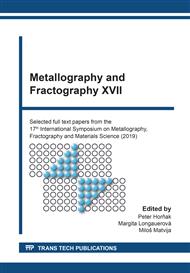p.277
p.282
p.288
p.294
p.300
p.306
p.312
p.318
p.324
Evaluation of Cavitation Damage in a Pipe Bend Made of 0.5Cr-0.5Mo-0.3V Steel by Optical Metallography and Replica Method
Abstract:
Prolongation of the service life of key components of fossil-fuelled power plants beyond their original design limit must be accompanied by thorough and extensive monitoring of the actual material state and particularly creep damage. The extent of cavitation is nowadays routinely tested in-situ by using replica method and its quantification is based on practices stated in VGB-TW 507, NORDTEST NT TR 302 derived from the original Neubauer's classification of cavitation damage. Evaluation of cavitation damage based on the measurement of the number of cavities and/or creep micro-cracks has become a routine activity, but in cases when steel contains large amount of non-metallic inclusions, they can be wrongly identified as cavities and to invalidate the result of calculation of cavitation damage. Comparative analysis of cavitation damage was performed in a pipe bend and its weldment made of a low-alloy 0.5Cr-0.5Mo-0.3V steel creep exposed at 540 °C for more than 225,000 hours by using OM (SEM) and replica method and revealed the comparative extent of cavitation damage decreasing from the outer to inner surface of the pipe wall.
Info:
Periodical:
Pages:
300-305
Citation:
Online since:
November 2020
Authors:
Keywords:
Price:
Сopyright:
© 2020 Trans Tech Publications Ltd. All Rights Reserved
Share:
Citation:


